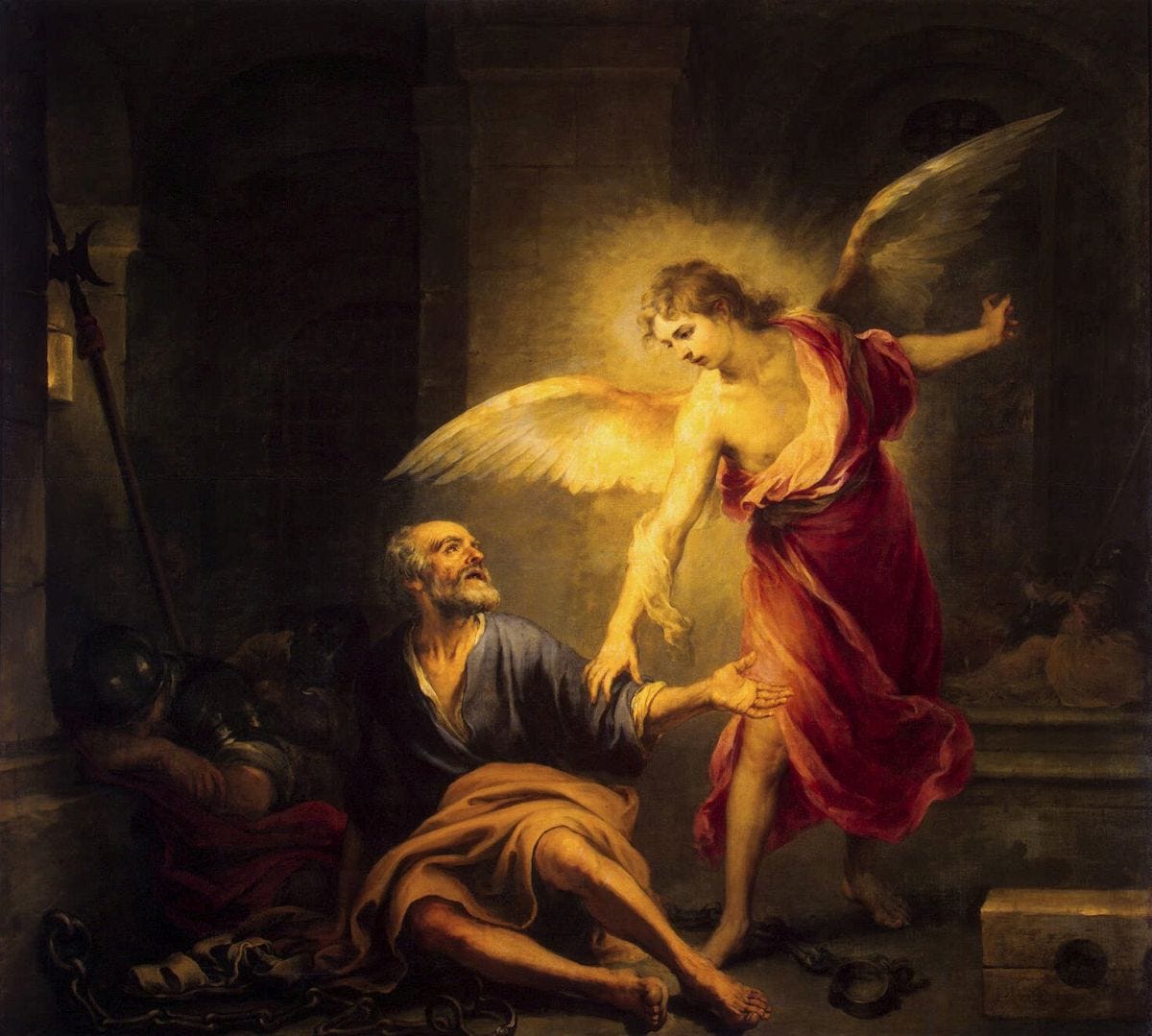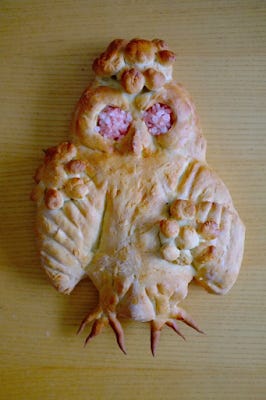On August 1 we recall two different things: the liberation of St. Peter from his imprisonment in Jerusalem, and the Seven Holy Machabees.
Today's feast is known in Latin as “Sancti Petri ad Vincula," and in English as both "St. Peter's Chains" and as "Lammas." On this day, we commemorate the escape of St. Peter from the chains that imprisoned him after he was arrested by Herod Agrippa I, son of Aristobulus IV, and nephew of Herod Antipas, who had St. John the Baptist put to death. We read in Acts 12 that Herod Agrippa had murdered St. James, the brother of St. John the Evangelist, then: seeing that it pleased the Jews, he proceeded to take up Peter also. Now it was in the days of the Azymes. And when he had apprehended him, he cast him into prison, delivering him to four files of soldiers to be kept, intending, after the pasch, to bring him forth to the people.
Peter therefore was kept in prison. But prayer was made without ceasing by the church unto God for him. And when Herod would have brought him forth, the same night Peter was sleeping between two soldiers, bound with two chains: and the keepers before the door kept the prison.
And behold an angel of the Lord stood by him: and a light shined in the room: and he striking Peter on the side, raised him up, saying: Arise quickly. And the chains fell off from his hands. And the angel said to him: Gird thyself, and put on thy sandals. And he did so. And he said to him: Cast thy garment about thee, and follow me.The chains that bound St. Peter were given to the Emperor Valentinian III's mother-in-law, by Iuvenalis, the Bishop of Jerusalem. The mother-in-law gave them to her daughter, who gave them to Pope St. Leo the Great. When Pope Leo brought the Jerusalem chains together with the chains St. Peter was bound with in Rome, by Nero, before his martyrdom, it's said that the two chains miraculously bound themselves together.
Many other miracles involving St. Peter's Chains are recounted throughout history, and we shouldn't wonder at their power: in Acts 5, we're told of the power of even St. Peter's shadow --And the multitude of men and women who believed in the Lord, was more increased: Insomuch that they brought forth the sick into the streets, and laid them on beds and couches, that when Peter came, his shadow at the least, might overshadow any of them, and they might be delivered from their infirmities.
-- about which the Roman Breviary says “if the shadow of [St. Peter’s] body could then bring help, how much more now the fullness of power?...Rightly is that iron of the chains of punishment considered to be more precious than gold throughout the churches of Christ.”
Pope St. Leo built a church to house these chains, a church known in Rome as San Pietro in Vincoli. Consecrated in A.D. 439 by Pope Sixtus III, it was the building of this basilica that inspired the Feast celebrated today. But there are many reasons to keep this feast and recall St. Peter's liberation; the Golden Legend lists a few, and among them is this:The fourth cause of the institution of this feast may be assigned here in this wise. For our Lord delivered S. Peter out of his chains by miracle, and gave him power to bind and to unbind. For we be holden and bounden unto the bond of sin and have need to be assoiled. Therefore we worship the solemnity of the chains aforesaid. For as he deserved to be unbound of the bonds of his chains, so received he power of our Lord Jesu Christ to assoil us.
One of the antiphons of today's Divine Office recounts what is said to have happened when St. Peter escaped his imprisonment in Rome: he was liberated by St. Processus and St. Martinian, and was told to leave before he could be recaptured and killed. On his route down the Appian Way to the port of Brindisi, where he wanted to get on a ship and head back to the Middle East, he met Christ. Shocked, he asked Him, "Domine, quo vadis?" ("Lord, where are you going?"). Jesus replied to him, "Venio Romam iterum crucifigi. ("I'm going to Rome to be crucified again.") At those words, St. Peter returned to Rome and embraced his martyrdom.1
Not all of the Church’s annual observances can be found on her official calendar. Throughout Catholic history, interesting folk customs, often in tandem with local agricultural cycles, have come to take on a religious significance. One such example is August 1. For many centuries it was the feast of St Peter’s Chains, while in the post-Vatican-II calendar it is the feast of St. Alphonsus Ligouri. But in medieval and Renaissance England, the first of August was better known as Lammas Day.
“Lammas” is a contraction of “Loaf Mass,” one of about two dozen words in the English language that have the word “Mas” or “Mass” in them. (Christmas is the most famous, but there are others as well.) Lammas Day was the first harvest festival of the season, the time to celebrate the first-fruits of the wheat and barley crops. These cereals were important to the Anglo-Saxons, as can be seen from other aspects of their language: the English word “lord” means “bread-guardian,” while “lady” means “bread-kneader.”
We know that Lammas Day was a feast of Bread, but we are not entirely certain how it was celebrated. Mention is made in some sources of taking a loaf to Mass that day to have it blessed, but unlike other seasonal blessings (such as those found in the Roman Ritual), there does not seem to be a specific formula. We do, however, have one fascinating fragment from a nonliturgical source that recommends blessed Lammas bread as a mouse repellent. If you place crumbs of blessed bread in the four corners of your barn, and a cross on the floor of the barn entrance with the Pater Noster written on both pieces of wood, your barn will be just like the city of Jerusalem, where mice “do not live and cannot have power”, and where they cannot “rejoice with the wheat”! [Eleanor Parker, Winters in the World: A Journey through the Anglo-Saxon Year (London: Reaktion Books, 2022), 196]2
People used the holiday as an important marker on the calendar. In Shakespeare’s Romeo and Juliet we learn that Juliet’s fourteenth birthday is on “Lammas-eve at night.” (I.iii.19) The festival was also used to designate property: “Lammas lands” were the fields used in common for winter grazing, while “Lammas wheat” was winter wheat, presumably planted in early August. And it helped in describing plants: “Lammas apples” were apples that ripened around August 1, while “Lammas growth” was the second set of shoots or leaves produced by a tree in the summer.
Lady Capulet:...Thou know'st my daughter's of a pretty age.
Nurse: Faith, I can tell her age unto an hour.
Lady Capulet: She's not fourteen.
Nurse:I'll lay fourteen of my teeth,--
And yet, to my teeth be it spoken, I have but four--
She is not fourteen. How long is it now
To Lammas-tide?
Lady Capulet: A fortnight and odd days.
Nurse: Even or odd, of all days in the year,
Come Lammas-eve at night shall she be fourteen.
Customs
One of the most important things you can do today is to think deeply about the qualities of virtue you possess -- or don't possess -- and become very conscious of and purposeful about acquiring the virtues the Machabees so valiantly displayed.
As to more folksy customs, you must know that the second English name for this day -- Lammas -- stems from the Old Englishhlaf, meaning "loaf," andmæsse, meaning "Mass." Breads were made and blessed on this day (a 9th c. martyrology refers to August 1 ashlafsenunga, or "'blessing of bread"), with some of them being destined for the altar. Gratitude to God for the harvest of "first fruits" -- the wheat needed for bread-making, the blueberries and blackberries that begin to ripen at ths time, etc., is one of the popular focuses of the day.
So, the baking of bread and having it blessed -- or, at least, marking it with a Cross before eating it -- would be a lovely thing to do. A no-knead recipe you can try:
No-Knead Bread
3 cups all-purpose or bread flour (+ a bit extra for later), aerated before measuring (just stir so air is incorporated)
1/4 teaspoon yeast (active dry or instant)
1 teaspoon salt
1 1/2 cups hot water, at about 125° F (no hotter than 140°!)
Mix well together flour, yeast and salt in a large bowl. Cover with plastic wrap and let stand at room temperature for at least 3 hours.
After at least 3 hours, when dough is dotted with bubbles, transfer it to a well-floured surface and sprinkle with a little flour. Fold dough over 10-12 times & shape into a rough ball, using a scraper to include all the dough. Place in a parchment paper-lined bowl, cover with a towel, and let stand for about 35 minutes.
Put a Dutch oven (one that's somewhere between 3 1/2 qt to 5 1/2 qt size should do) with an oven-safe lid in a cold oven and preheat to 450° F. When the oven and Dutch oven are both hot, carefully remove lid from the latter and place the dough inside along with the parchment paper it's sitting on. Cover and bake for 30 minutes. After 30 minutes, remove lid and parchment, return uncovered to the oven, and bake 10 to 15 minutes more. Cool and eat.
Lammas Eve & Other Spooky Feast Days…
Lammas Day was, at least in some places or some times, an occasion of great festivity. The Ould Lammas Fair in Northern Ireland, for example, has been celebrated more or less continually for four hundred years--even though it is now held near the end of August.
https://fisheaters.com/customslammas.html
https://www.newliturgicalmovement.org/2023/07/lammas-day.html







